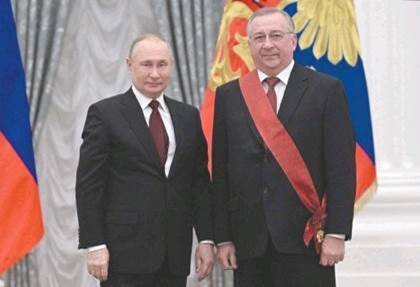
RUSSIAN PRESIDENT Vladimir Putin poses with Russian oil pipeline monopoly Transneft CEO Nikolai Tokarev, after the latter was awarded the title of Hero of Labor of the Russian Federation during a ceremony at the Kremlin last month.
We can say it out loud: Europe has been caught with its trousers down. However and whenever Russia’s war against Ukraine ends, Europe’s relationship with its main gas supplier, Russia, will never be the same. For now, the EU members to a greater (e.g., Germany) or lesser (e.g., the UK) extent, depending on how severe their dependence is on Russian imports are shooting in all directions.
They are saying they will cut Russian gas by two-thirds by the end of this year and fully end their dependence on Russian fossil fuels by 2027 – a very ambitious move. They want to source liquefied natural gas (LNG) either directly from producers or by pleading with consumers in Asia to redirect cargoes to them (but both global supplies and regasification infrastructure in Europe are lacking).
They want to increase the volume of gas to put in storage to 90% by October, to speed up even more the transition to renewables (but that didn’t work too well for them last year and made them burn peak volumes of coal in 2021), to conserve and turn down the thermostat by a degree and increase polluting coal power generation.
While they are trying to consider their short-term (energy security, higher costs, diversification) and long-term options (higher degree of decarbonization), it all shows that they have been caught with their trousers down. Indeed, none of these changes can happen overnight.
Altering the course of a continent’s energy policy takes years, if not decades to achieve in a safe and reliable manner. Banks have been warning the Europeans about the various scenarios they could face in terms of energy costs, with the “good scenario” whereas the Ukraine war is resolved relatively quickly still being horrendous in terms of energy implications for Europe if not the world.
US ON A SOMEWHAT BETTER FOOTING?
According to the US Energy Information Administration, the US imported 199,000 barrels a day of Russian crude and 473,000 b/d of petroleum products, amounting to 8% of total US petroleum imports and 3.3% of its crude imports. US refineries are likely to replace these barrels from countries such as Ecuador and Colombia which would both be equal in quality to the Russian oil and the short distance would avoid surging tanker rates.
In the meantime, US shale producers are being asked to increase production, but this is not an easy feat, as steps taken previously either by the administration, investors or events that happened all take considerable time to reverse. These include supply chain problems, inflation, labor shortages, pressure by investors for immediate returns, low carbon policies promoted by the Biden administration, refusing to give out drilling licenses, massive underinvestment in the petroleum sector and of course, market volatility.
AND WHERE DOES THIS LEAVE ISRAEL IN ALL THIS?
There are three main aspects to look at: (1) imports of oil, (2) power generation in Israel and (3) exports of gas to our neighbors and the wider world.
Regarding oil, Israel is in the same shaky boat as the rest of the world. It consumes over 90 million barrels of oil a year and each $10 hike in the price of a barrel of oil amounts to additional import costs of close to $1 billion a year and has political implications in that it provides petrol dollars and power to the countries from whom Israel buys the oil, including Russia.
Power generation is carried out at a rate of 23% from coal, 8% from renewables and 69% from natural gas. Out of these three sources, two are locally produced (gas and renewables), whilst coal is the dirtiest and most expensive, providing no taxes to the Israeli treasury and the only source imported, inter alia is from Russia. After capital and operational expenses have been recuperated, Israel gains about 62% of the profits on the gas, over the full life cycle of the supplies.
Israel is self-sufficient in terms of its power generation as it can gradually, but assuredly, reduce and finally end all coal generation by the end of 2025. At this stage, all efforts must be made to reduce coal generation and increase gas and renewable energies.
Regarding the export of gas, EU leaders are seeking a means to interconnect ever more between them with electricity grids, gas pipelines, potential joint purchases of gas, and so on.
Israel, too, in its own neighborhood must and is ensuring the interconnectivity of its gas network, which enables gas to flow from Israel to Jordan and Egypt, or eventually even north to Lebanon. The gas from Israel to Egypt can also be liquefied and reach Europe. These connections are vitally important, as they keep the lights on in Jordan, money replenished into the Israeli treasury, and enhances Israel’s standing as a reliable energy supplier to the region and to Europe.
In conclusion, the world is experiencing an unprecedented energy crisis and in order to survive it in the best way possible, it must first and foremost adopt a realistic approach, especially Europe.
Israel must learn from Europe’s distress and reach important conclusions: Longterm skillful planning is paramount rather than taking populistic decisions (the Ministry of Energy needs to consult with experts in the sector), make optimal use of the country’s indigenous natural gas resources, and examine how to grasp the opportunity to become a reliable and stable diversified source of supply to the region and Europe.




 Phone:
Phone: Email:
Email: